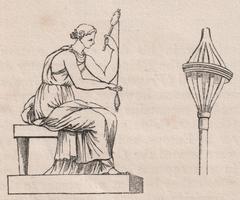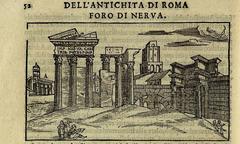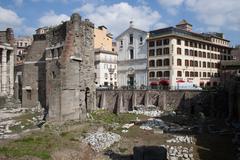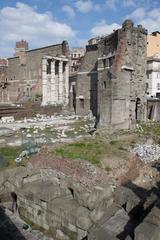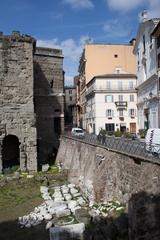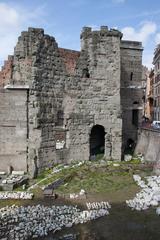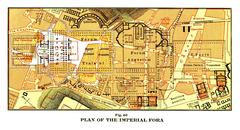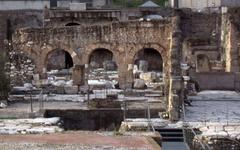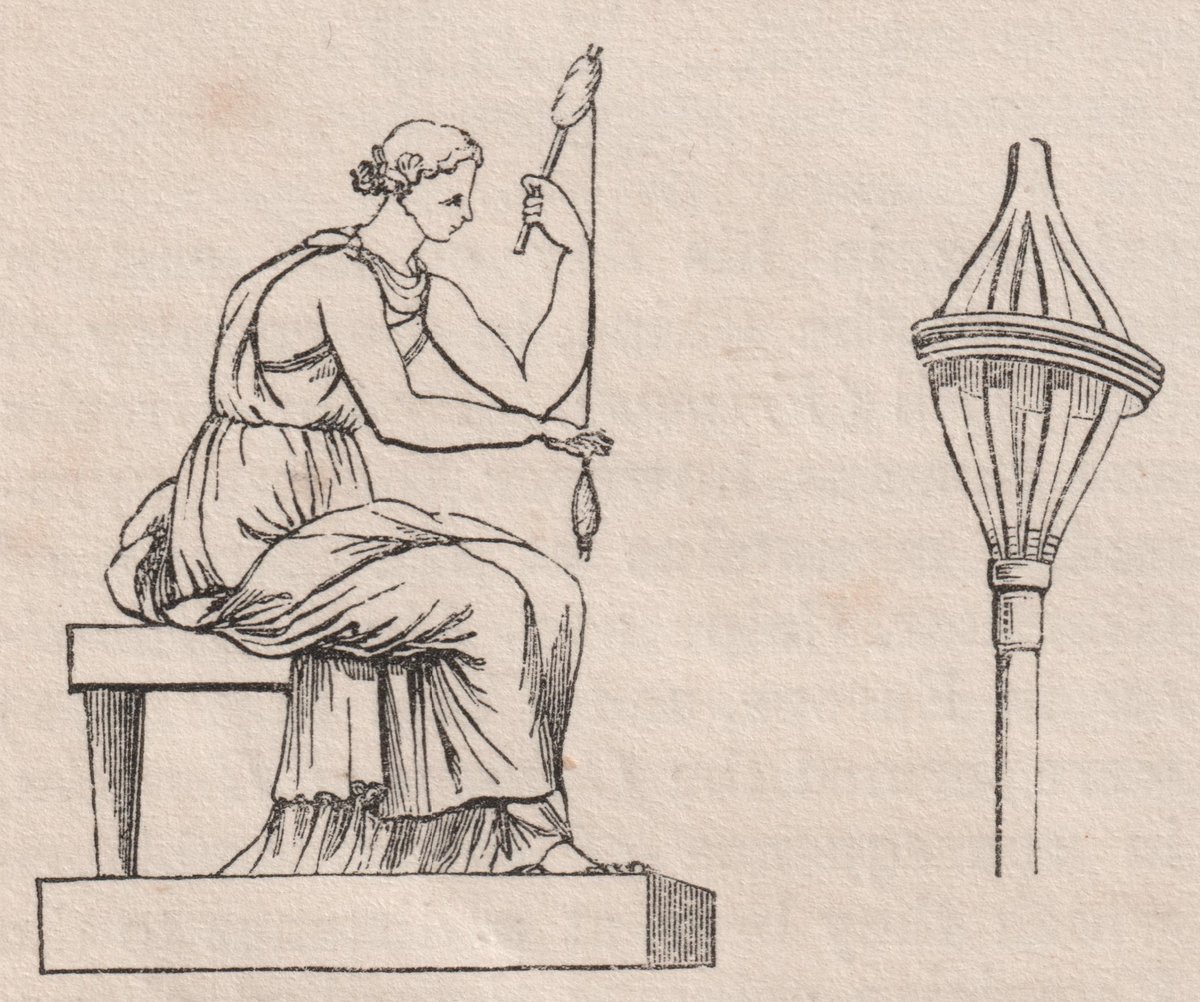
Forum Nervae Visiting Hours, Tickets, and Travel Guide: Rome Historical Sites
Date: 14/06/2025
Introduction
The Forum Nervae—also known as the Forum Transitorium or Forum of Nerva—is a significant yet often overlooked gem among Rome’s imperial forums. Built at the end of the 1st century CE, it demonstrates the ingenuity of Roman urban planning, architectural adaptation, and the deep intertwining of political and religious life during the Flavian and early Nerva-Antonine periods. Conceived under Emperor Domitian and completed by his successor Nerva in 97 CE, the forum’s narrow, elongated layout was a masterful response to the spatial constraints between the Forums of Caesar, Augustus, and the Temple of Peace. Its most prominent features include the Temple of Minerva and the iconic “Colonnacce” columns, which still stand as a testament to Rome’s enduring legacy.
This comprehensive guide will provide you with essential details for planning your visit: opening hours, ticketing, accessibility, travel tips, nearby attractions, and the best ways to experience this unique historical site. Whether you are a history aficionado or a traveler eager to uncover Rome’s layers, the Forum Nervae offers a window into the city’s imperial grandeur (Musei in Comune Roma, Ancient Rome Live, Summer in Italy).
Contents
- Introduction
- Historical Overview
- Origins and Construction
- Architectural Features
- Political and Religious Significance
- Later History and Archaeological Rediscovery
- Visitor Information
- Opening Hours
- Tickets and Admission
- Accessibility
- Guided Tours and Special Events
- How to Get There
- Nearby Attractions
- Visuals and Media
- Practical Visitor Tips
- Events and Special Considerations for 2025
- Frequently Asked Questions (FAQ)
- Conclusion
- Sources
Historical Overview
Origins and Construction
The Forum Nervae was initiated under Emperor Domitian to complete Rome’s sequence of imperial forums and optimize the limited land between the Forums of Caesar, Augustus, and the Temple of Peace. Its construction began in the late first century CE and was finished by Nerva in 97 CE. The forum was strategically placed along the ancient Argiletum, a street vital for connecting the Roman Forum to the Subura district, resulting in its elongated and corridor-like design (Musei in Comune Roma, Ancient Rome Live).
Architectural Features
Measuring about 120–125 meters long and 45 meters wide, the Forum Nervae was narrower than its neighboring forums. The western end featured the Temple of Minerva, distinguished by a six-columned Corinthian portico, Phrygian marble, and elaborate friezes symbolizing wisdom and imperial protection. The forum’s most recognizable remnants are the “Colonnacce”—two standing columns topped with an entablature and reliefs depicting Minerva and mythological scenes. The forum’s walls were lined with engaged columns and decorative motifs, maximizing the sense of grandeur within a confined space (Ancient Rome Live, My Rome Pass).
Political and Religious Significance
Dedicated to Minerva, the patron goddess of Domitian, the Forum Nervae was both a political and religious statement. Its completion by Nerva, following Domitian’s assassination and subsequent damnatio memoriae, signaled continuity and stability. The forum served as a ceremonial thoroughfare—hence “Forum Transitorium”—and a hub for commerce, worship, and public gatherings (Musei in Comune Roma, Wikipedia).
Later History and Archaeological Rediscovery
Through the Middle Ages, the forum’s buildings were repurposed for housing and city infrastructure. In 1606, Pope Paul V ordered the demolition of the Temple of Minerva, using its materials for new monuments. Systematic archaeological excavations in the 20th century revealed much of the forum, though some areas were affected by the construction of Via dei Fori Imperiali. Today, the “Colonnacce” and sections of the forum wall remain visible, offering insight into its original form (Platner, 1929, Ancient Rome Live).
Visitor Information
Opening Hours
- General Hours: Daily from 9:00 AM to 7:00 PM (last admission at 6:00 PM–6:30 PM).
- Seasonal Variations: Hours may change during special events or holidays; always check official sources before your visit (tour.rome.it).
Tickets and Admission
- Ticketing: Entry to the Forum Nervae is included in the combined ticket for the Roman Forum, Palatine Hill, and Imperial Fora.
- Prices: Standard adult tickets are approximately €16 (as of June 2025), with reduced rates for EU citizens aged 18–25 and free entry for children under 18. Roma Pass and other city tourist cards also cover entry (romeactually.com, visititaly.eu).
- Purchase: Tickets can be bought online via the Parco Colosseo website or at ticket offices near the Colosseum and Roman Forum.
Accessibility
- The archaeological park features uneven ancient pavements. Some areas are accessible via ramps and designated pathways, but mobility-impaired visitors should check details in advance or contact the site for the latest accessibility information.
Guided Tours and Special Events
- Guided Tours: Available in multiple languages and highly recommended for in-depth understanding.
- Night Tours: Summer months often feature special multimedia installations and nighttime tours, including immersive projections and audio narratives (romeactually.com).
- Audio Guides and Apps: Digital resources, such as the Audiala and Parco Colosseo apps, offer interactive maps and detailed commentary.
How to Get There
- Location: Central Rome, between the Forum of Augustus and the Forum of Peace.
- Main Entrance: Largo della Salara Vecchia.
- Public Transit: Metro stations (Colosseo, Cavour) and several bus lines are nearby. The area is also easily walkable from other major attractions.
Nearby Attractions
- Combine your visit with the Colosseum, Roman Forum, Palatine Hill, Forum of Augustus, and Capitoline Museums—all within short walking distance and often included in combined tickets.
Visuals and Media
- Key Sights: The “Colonnacce” (standing columns with Minerva reliefs), Temple of Minerva ruins, engaged columns, and the Porticus Absidata.
- Photography: Allowed for personal use; tripods and drones may require special permission.
- Alt Tags: Use descriptive alt text for images, such as “Forum Nervae ruins along Via dei Fori Imperiali, Rome” and “Colonnacce columns with Minerva reliefs at Forum Nervae.”
Practical Visitor Tips
- Best Time to Visit: Early morning or late afternoon to avoid crowds and heat, especially in June and during the 2025 Jubilee (untolditaly.com).
- What to Bring: Comfortable walking shoes, refillable water bottle (public fountains are available), sunscreen, and a hat.
- Health & Safety: Be mindful of pickpockets in crowded areas and follow posted guidelines to help preserve the site.
- Cultural Etiquette: Greet staff and guides politely, respect barriers, and avoid touching ancient structures.
Events and Special Considerations for 2025
- Jubilee 2025: Expect increased crowds and possible changes in hours or access due to special events (visititaly.eu). Book tickets and accommodation well in advance, and check the official Jubilee calendar for updates.
Frequently Asked Questions (FAQ)
Q: What are the Forum Nervae visiting hours?
A: Generally, daily from 9:00 AM to 7:00 PM; last entry 6:00–6:30 PM. Always check official sources for seasonal changes.
Q: How much do tickets cost?
A: Standard adult tickets are approximately €16, with reduced rates for EU citizens aged 18–25 and free entry for children under 18. Tickets cover multiple Imperial Fora sites.
Q: Is Forum Nervae accessible for people with disabilities?
A: Some areas are accessible via ramps; however, much of the terrain is uneven. Confirm details in advance.
Q: Are guided tours available?
A: Yes, guided and audio tours are available and highly recommended. Nighttime multimedia tours are also offered in summer.
Q: Where can I buy tickets?
A: Online at Parco Colosseo or at ticket offices near major Roman landmarks.
Q: Is photography allowed?
A: Yes, for personal use. Tripods and drones may require permission.
Conclusion
The Forum Nervae stands as a testament to Roman ingenuity, blending architectural adaptation with political and religious symbolism. Its compact, corridor-like design and rich decorative program offer a unique glimpse into the challenges and ambitions of late first-century Rome. Despite the loss of much of its original structure, surviving features such as the “Colonnacce” and the archaeological context continue to illuminate its importance within the broader imperial complex.
By leveraging the practical information and travel tips provided in this guide, visitors can fully appreciate the Forum Nervae’s unique place in Rome’s heritage. Combine your visit with adjacent sites, use interactive resources like the Audiala app, and immerse yourself in the layers of history that define the Eternal City.
Sources
- Musei in Comune Roma: Foro di Nerva
- Madain Project: Forum of Nerva
- Ancient Rome Live: Forum Nervae (Forum Transitorium)
- Tour.Rome.it: Foro di Nerva
- Untold Italy: Rome Jubilee 2025 Tips
- Summer in Italy: Forum of Nerva
- Platner, S. B. (1929): Forum Nervae
- Rome Actually: Visiting Rome in June
- Visit Italy: Jubilee 2025 in Rome
- My Rome Pass: Forum of Nerva
- Wikipedia: Forum of Nerva
- Imperium Romanum: Forum of Nerva
- Parco Colosseo
